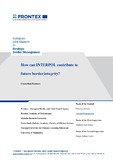| dc.contributor.author | di Carlo, Fabrizio | |
| dc.contributor.other | Nolan, Anthony Jack, First Supervisor | |
| dc.contributor.other | Vasile, Sergiu Adrian, Second Supervisor | |
| dc.contributor.other | Frontex –European Border and Coast Guard Agency | |
| dc.date.accessioned | 2020-04-03T07:01:41Z | |
| dc.date.available | 2020-04-03T07:01:41Z | |
| dc.date.issued | 2017 | |
| dc.identifier.uri | https://digiriiul.sisekaitse.ee123456789/2446 | |
| dc.description | 1. Introduction ; 1.1. Questions ; 1.2. Research Justification and relevance of the research ; 1.3. Organisation of the Dissertation ; 1.4. Conclusion ; 2. Literature Review ; 2.1 Introduction ; 2.2 Setting the Scene ; 2.3 A borderless world ; 2.4 A Theoretical Framework for a Borderless World ; 2.4.1 The Pre-Emptive Concept ; 2.4.2 The extended use of technology ; 2.5 INTERPOL as enabler of Border Integrity ; 2.6 The emergence of virtual borders and their operationalization through the SMART border
initiative ; 2.6.1 The evolution of SMART border ; 2.6.2 The component elements of SMART borders ; 2.6.3 INTERPOL and SMART Border Initiative ; 2.7 SMART border and seamless travel ; 2.7.1 International Travel Volumetric ; 2.7.2 Models of Digital Identity ; 2.7.3 The seamless travel experience ; 2.7.4 The ethical dilemma around the use of biometric information for border control ; 2.8 Conclusion ; 3. Research Methodology ; 3.1 Research design ; 3.2 Description of the Case Study ; 3.2.1 The IBM concept as unit of analysis in the current border environment ; 3.2.2 The WEF concept as unit of analysis in the future seamless border environment ; 3.3 Data Collection Methods ; 3.4 Settings and participants ; 3.5 Data analysis ; 3.6 Quality ; 3.7 Ethical considerations ; 3.8 Conclusions ; 4. Analysis and Results ; 4.1 Introduction ; 4.2 Analysis of the Interview Questions – Section 1 ; 4.2.1 Introduction ; 4.2.2 Analysis ; 4.2.3 Findings ; 4.3 Analysis of the Interview Questions – Section 2 ; 4.3.1 Introduction ; 4.3.2 Analysis ; 4.3.3 Findings ; 4.4 Analysis of the Interview Questions – Section 3 ; 4.4.1 Introduction ; 4.4.2 Analysis ; 4.4.3 Findings ; 4.5 Conclusions ; 5. Conclusions and Recommendations ; 5.1 Introduction ; 5.1.1 The conclusion that emerged from the analysis ; 5.1.2 INTERPOL takes a stance in promoting border integrity ; 5.1.3 INTERPOL appears well positioned within the current border environment ; 5.1.4 The forthcoming challenges for INTERPOL to become an EU recognized partner by law ; 5.1.5 Seamless ; 5.1.6 Significance of the findings ; 5.1.7 Implication for future research ; 5.2 Recommendation ; 5.2.1 What INTERPOL should do | et_EE |
| dc.description.abstract | The objective of this research is to identify how INTERPOL’s border elements can be operationalized within national and regional border programs so contributing to enhance global integrity. The research first offers an analysis of the theoretical frame of the ’borderless’ world of the 90s, inspired by the globalization elements of the economic integration and free trade, and driven by the viewpoint of the neo-liberal. Next it assesses the rapid reinforcement of border security within governmental agendas in the aftermath of the 9/11 terrorist attacks in the United States and the extended collaboration with the private sector, especially information technology,transportation, and private security companies, in line with the development of the doctrine known as ‘NPM’ (new public management)which asserts the supposed superiority of private managerial techniques that would lead to improvement in the efficiency and effectiveness of government services. In contrast, the research also analyzes the viewpoints critical to the NPM doctrine such as the ‘whole-of-government’ movement which advocates for holistic private-public collaboration methods to improve government processes. Thirdly,it offers insight into the processes and the technologies that are driving the global evolution of border management, including the ‘seamless journey’ concept that harnesses biometric systems shared by smart cities that properly recalibrated can be utilized in border settings. | et_EE |
| dc.language.iso | en_US | et_EE |
| dc.publisher | Frontex | et_EE |
| dc.subject | Frontex | et_EE |
| dc.subject | Euroopa Liit | et_EE |
| dc.subject | piirikontroll | et_EE |
| dc.subject | piirid (territ.) | et_EE |
| dc.subject | Rahvusvaheline Kriminaalpolitsei Organisatsioon | et_EE |
| dc.subject | piirideta maailm | et_EE |
| dc.subject | border control | |
| dc.subject | borders | |
| dc.title | How can INTERPOL contribute to future border integrity? | et_EE |
| dc.type | Thesis | et_EE |



